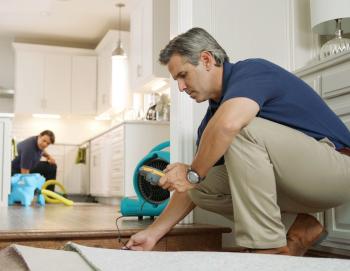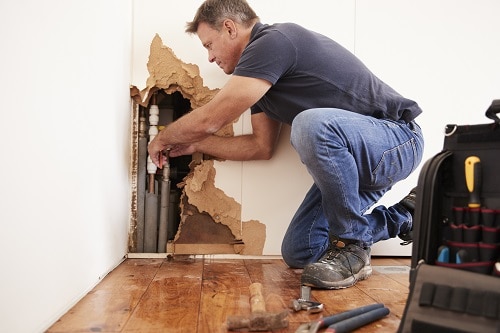How Water Damage Restoration preserves your home from mold
Wiki Article
Leading Tips for Effective Water Damage Restoration: Protect Your Residential Property Today
Water damage can strike all of a sudden, triggering significant disruption and prospective hazards. Reliable restoration calls for a systematic approach to reduce further injury. From examining the damage to carrying out preventative procedures, each step plays an essential function in protecting home. Understanding these methods can make all the difference in the results of a water-related situation. What important actions should be prioritized to ensure extensive defense?Evaluate the Damage Right Away
When a water damage event takes place, it is necessary to assess the damage immediately to mitigate additional issues. This preliminary analysis assists identify the level of the damage and identifies impacted locations. Water can leak into walls, floorings, and furnishings, resulting in mold growth and architectural instability if not resolved quickly. A thorough evaluation needs to consist of looking for discoloration, moisture, and stuffy odors, which show moisture existence. It is additionally essential to record the damage via photographs and notes for insurance coverage functions. Involving specialists for a much more in-depth analysis might be required, especially when taking care of surprise or considerable damage. Water Damage Restoration. Early recognition and accurate evaluation lay the structure for efficient restoration and protect the property from extra issuesShut down the Water
Shutting off the supply of water is a crucial action in preventing more damage throughout a water-related case. When a leak or flooding occurs, instant activity is essential to decrease the level of the damage. Finding the major water shut-off shutoff ought to be a priority. This valve is typically positioned near the water meter or where the water line enters the residential property. When located, turning the valve clockwise will stop the circulation of water. In situations where the main valve is hard to reach, specific shut-off shutoffs for devices may also be utilized. Promptly closing off the water supply not just protects the residential or commercial property from additional damage yet additionally assists in the subsequent restoration procedure, making sure that healing efforts can begin immediately.Eliminate Excess Water Without Delay

Eliminating excess water without delay is vital for lessening damage and protecting against mold growth in influenced areas. The longer water stays touching materials such as wood, insulation, and drywall, the greater the threat of architectural damage and the advancement of mold and mildew. Water Damage Restoration. Property owners need to act rapidly to analyze the scenario and use suitable tools, such as wet vacuums or pumps, to draw out standing water efficiently. If the volume of water is considerable, speaking to professional restoration services might be necessary, as they can supply customized devices and proficiency. Furthermore, getting rid of furniture and possessions from the damaged area can help to decrease damage and promote the general restoration process. Timely action not only safeguards residential or commercial property however likewise aids in a smoother healing trip
Dry the Affected Location
After eliminating excess water, it is important to dry out the affected area completely. This entails eliminating any standing water and enhancing air circulation to help with evaporation. Efficient drying will help protect against mold and mildew development and further damage.
Remove Standing Water
Promptly resolving standing water is critical for efficient water damage restoration. The existence of stationary water can cause further home damage and produce a setting for mold and mildew development. To mitigate these dangers, it is important to remove standing water as swiftly as possible. This process commonly entails making use of completely submersible pumps, damp vacuums, or specialized extraction equipment. Professionals advise examining the deepness and level of the water prior to selecting the proper method for removal. Safety and security safety measures ought to also be taken, including putting on protective gear and guaranteeing electrical power is shut off in impacted locations. As soon as the standing water is effectively removed, the drying procedure can start, even more protecting the residential property from continuous damage.Increase Air Flow
Boosting air blood circulation is vital for efficiently drying areas impacted by water damage. This process aids to speed up dissipation, decreasing the danger of mold and mildew development. Experts often suggest making use of fans to informative post produce a steady air flow throughout the area. Placing box fans in home windows can attract fresh air, while high-velocity fans can direct air flow in the direction of wet surfaces. Flood Cleanup Services. Furthermore, opening up windows and doors enables for cross-ventilation, improving the drying out procedure. Dehumidifiers can likewise be employed to get rid of excess dampness from the air, additional assisting in drying. By making sure that air flows openly, residential property proprietors can considerably decrease the long-term effects of water damage and secure the stability of their structureInspect for Mold Growth
Mold growth is a major issue following water damage, as it can cause health issues and architectural deterioration. After any kind of flooding or leakages, it is necessary to conduct a thorough evaluation of the affected areas. This includes checking surprise areas such as behind walls, under carpets, and in attics or cellars where wetness might remain. Signs of mold and mildew include a mildewy smell, discoloration on surface areas, or visible development. Property proprietors ought to make use of protective gear when checking, as mold and mildew spores can position health and wellness threats. If mold and mildew is found, it is crucial to address it instantly, as delaying removal can worsen the problem and raise the danger of major health worries for occupants. Early treatment is key to efficient mold and mildew monitoring.

Repair Work and Restore Broken Structures
When resolving water damage, it is important to initial assess the structural honesty of the affected areas. This assessment aids determine possible risks and educates the required repair techniques. Involving specialist restoration solutions ensures that the restoration procedure is carried out securely and properly.Assess Structural Stability First
Prior to launching any type of water damage restoration, it is necessary to assess the architectural honesty of the affected area. This examination aids identify any compromised elements, such as beams, wall surfaces, or foundations, which may present safety and security dangers - Water Damage Restoration. Inspecting for indications of warping, fracturing, or mold growth is critical, as these indicators can reveal underlying damage that requires immediate interest. Furthermore, recognizing the level of the damage can direct restoration efforts and figure out whether fixings are viable or if substitute is necessary. It is essential to document findings completely, as this information can be important for insurance policy cases or future referral. Prioritizing structural assessment guarantees that restoration initiatives continue securely and successfully, ultimately shielding the home and its residentsUse Professional Restoration Services
Utilizing professional restoration solutions is crucial for efficiently repairing and recovering broken structures after water events. These experts possess the necessary training, tools, and experience to minimize and analyze water damage completely. They can determine covert problems, such as mold development and architectural weaknesses, that might not be immediately noticeable. Specialist services also use advanced drying strategies and tools, making sure that all dampness is eliminated to stop further damage. In addition, they abide by sector requirements and policies, ensuring that the restoration procedure is effective and safe. By involving restoration specialists, residential or commercial property owners can expedite recuperation, decrease lasting damage, and ultimately secure their investment. This positive strategy is crucial in maintaining the stability and safety and security of damaged frameworks.Protect Against Future Water Damage
To successfully protect against future water damage, house owners need to take on a positive method to repair and maintenance. Regular assessment of downspouts, gutters, and roofings is essential; stopped up seamless gutters can result in water overflow and roof covering leaks. Furthermore, examining for leakages in pipes components and devices can prevent possible damage. Homeowners ought to additionally take into consideration installing sump pumps in basements or low-lying locations to take care of water build-up. Sealing fractures in foundations and guaranteeing proper drain around the residential or commercial property are essential steps in protecting versus water breach. Furthermore, keeping humidity levels with dehumidifiers can avoid mold development. By implementing these preventive procedures, property owners can considerably lower the threat of water damage and safeguard their residential property for the long term.When a water damage event happens, it is essential to assess the damage immediately to mitigate more issues (Mold Remediation After Water Damage). Removing excess water without delay is necessary for decreasing damage and preventing mold growth in impacted locations. Promptly resolving standing water is important for efficient water damage restoration. The existence of stagnant water can lead to more residential or commercial property damage and create a setting conducive to mold growth. Prior to initiating any kind of water damage restoration, it is vital to evaluate the structural stability of the afflicted area
Report this wiki page